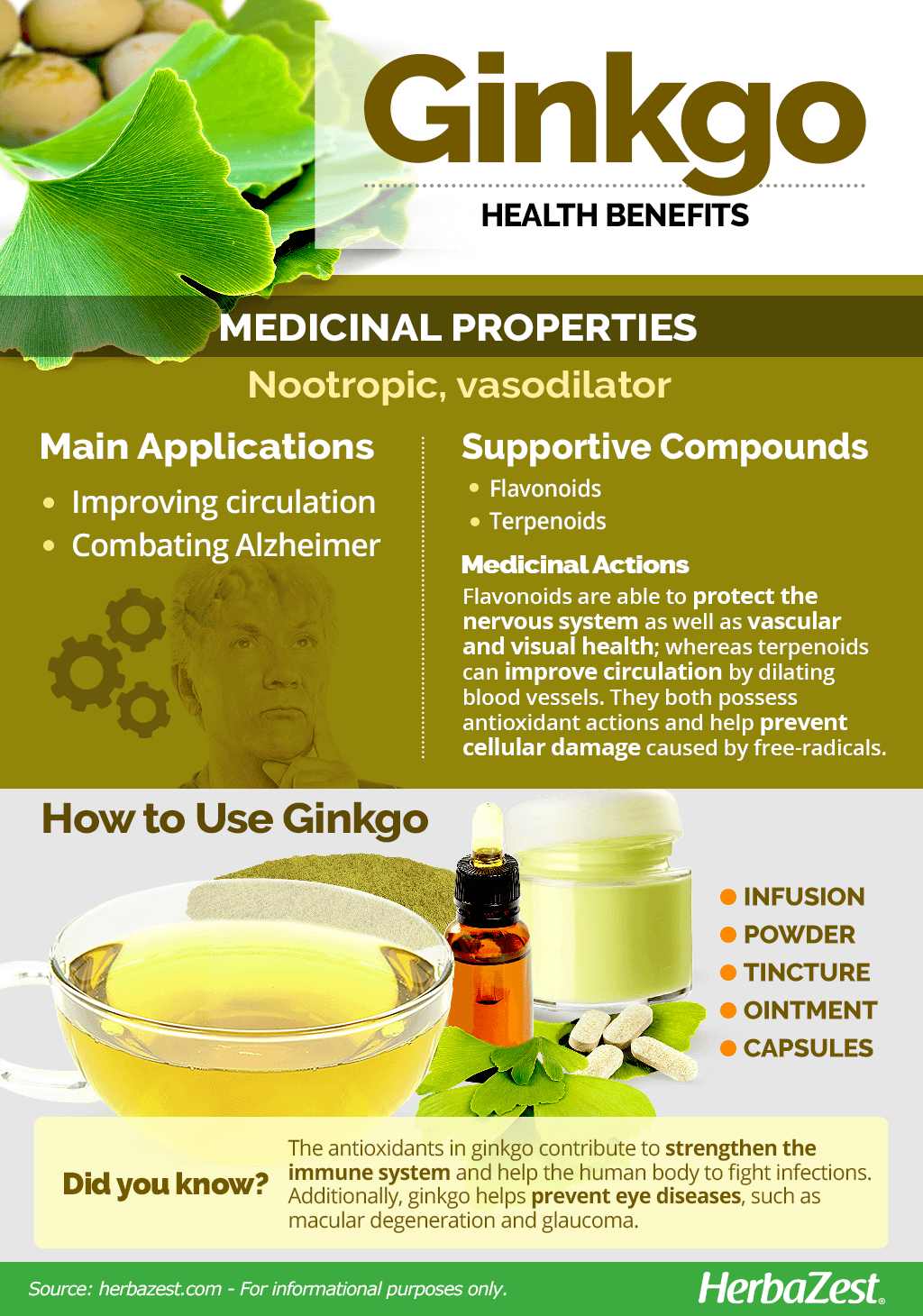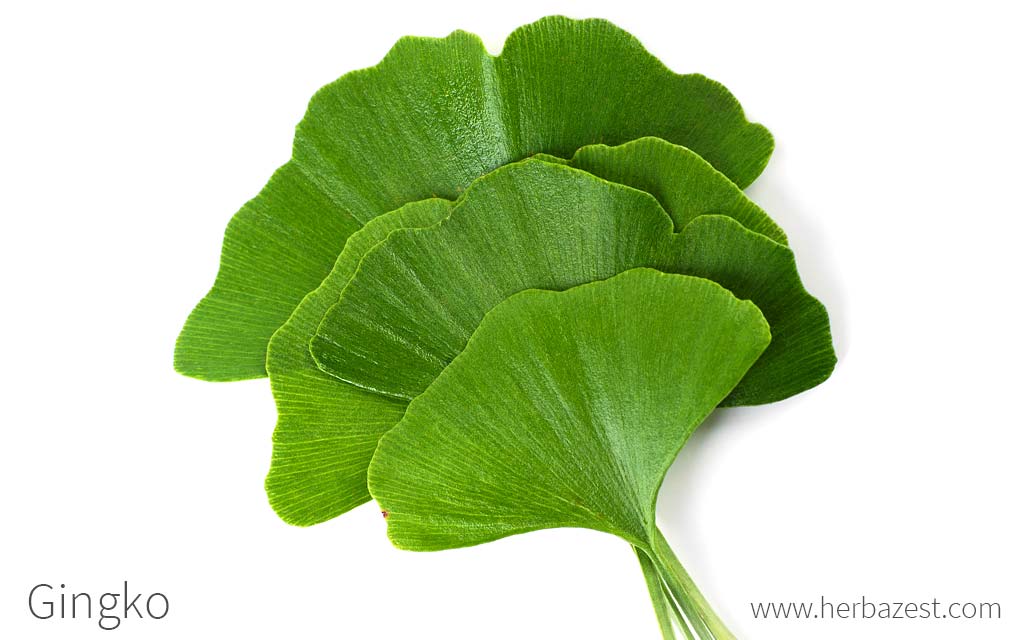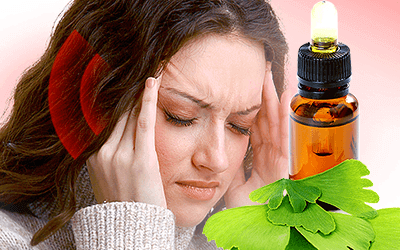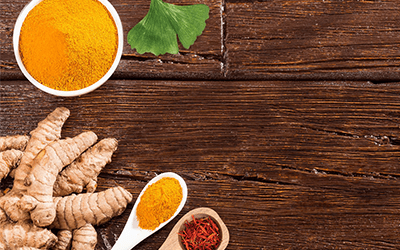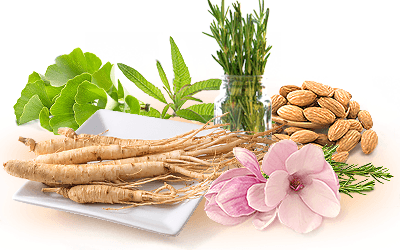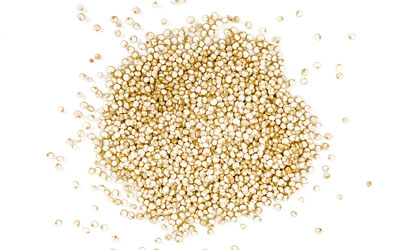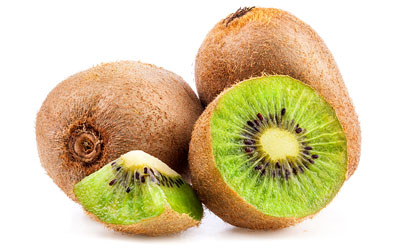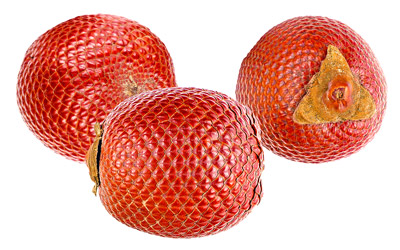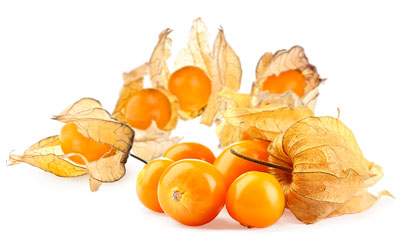Ginkgo - sometimes known as maidenhair tree - is a unique species in that it has been dated back to around 270 million years ago, predating even the dinosaurs. It is often referred to as a “living fossil” for this reason, and ginkgo biloba is the only species to have survived the plants' genetic order. It originated in China and has a secure position as a valued herb in traditional Chinese medicine. Its uses have become known across the world, and so it is now cultivated globally.
Ginkgo Medicinal Properties
Ginkgo has many uses in traditional Chinese medicine, which have been partially emulated in some herbal remedies in Western medicine. These applications have led to interest from the scientific community, and, therefore, much research has been carried out to determine exactly which properties ginkgo possesses that may be beneficial to human health. Some of the conditions it is thought to be able to treat are:
Improving circulation. Compounds within ginkgo can dilate blood vessels, thereby enabling blood to flow more freely throughout the body.
Combating dementia. It is thought that ginkgo's ability to stimulate blood flow to the brain has the potential to stave off dementia and protect the nerve cells damaged by Alzheimer's.
Additionally, ginkgo is also popularly used for:
Supporting the immune system. Ginkgo contains antioxidants which can help the human body to maintain efficient functionality and resist infections.
Preserving eye health. The plant is thought to protect the retina, thereby limiting the chances of developing eye diseases, such as macular degeneration and glaucoma.
Although there is currently no scientific evidence to support these theories, it has been claimed that ginkgo can treat various other ailments, such as vertigo, skin diseases, and respiratory complaints including asthma.
How it Works
Over 40 chemical components are known to exist in ginkgo. However, only two - flavonoids and terpenoids - are regarded as medicinally advantageous due to their potent antioxidant activity.
Antioxidants are hugely beneficial to the human body for a number of reasons. They fight free radicals, which are pollutants that harm the integrity of cells. Minimizing the amount of these harmful compounds enables the body to sustain an effective immune system, which guards against infections such as the common cold. The anti-inflammatory and antioxidant effects of ginkgo have been suggested by a number of studies to be effective against neurodegenerative and age-related diseases. 1,2
Flavonoids are able to protect and support nerves, blood vessels, and retinas, and terpenoids can improve circulation by dilating blood vessels.3
Ginkgo biloba leaves are also rich in polysaccharides, which have been shown to promote hair growth.4
Amaranth and blackberry offer protection against neurodegenerative diseases, while dong quai increases blood flow and camu camu promotes healthy vision.
Ginkgo Side Effects
Ginkgo leaves are largely considered safe for consumption. However, there are possible side effects caused by excess consumption. These include headaches, stomach upsets, and skin irritations to those who have sensitive skin.
Women who are pregnant or breastfeeding should seek advice from a health professional before regular intake of any herbal supplement.
Ginkgo Cautions
The fruit and seeds contain a substance called ginkgotxin, which is poisonous and can cause vomiting, loss of consciousness, and, in extreme cases, death. If thoroughly cooked, this toxin can be eliminated, but it is generally advised not to consume the fruit and seeds at all. The medicinal properties are more highly concentrated in the leaves, so most supplements are derived from these rather than any other component of the plant.
Due to the effect it can have on circulation, people who take blood thinning medicine should consult their physician before using any ginkgo preparation in order to avoid the risk of excessive bleeding in case of physical trauma or surgery.
- Medicinal action Nootropic, Vasodilator
- Key constituents Flavonoids and terpenoids
- Ways to use Capsules, Hot infusions/tisanes
- Medicinal rating (4) Very useful plant
- Safety ranking Safe
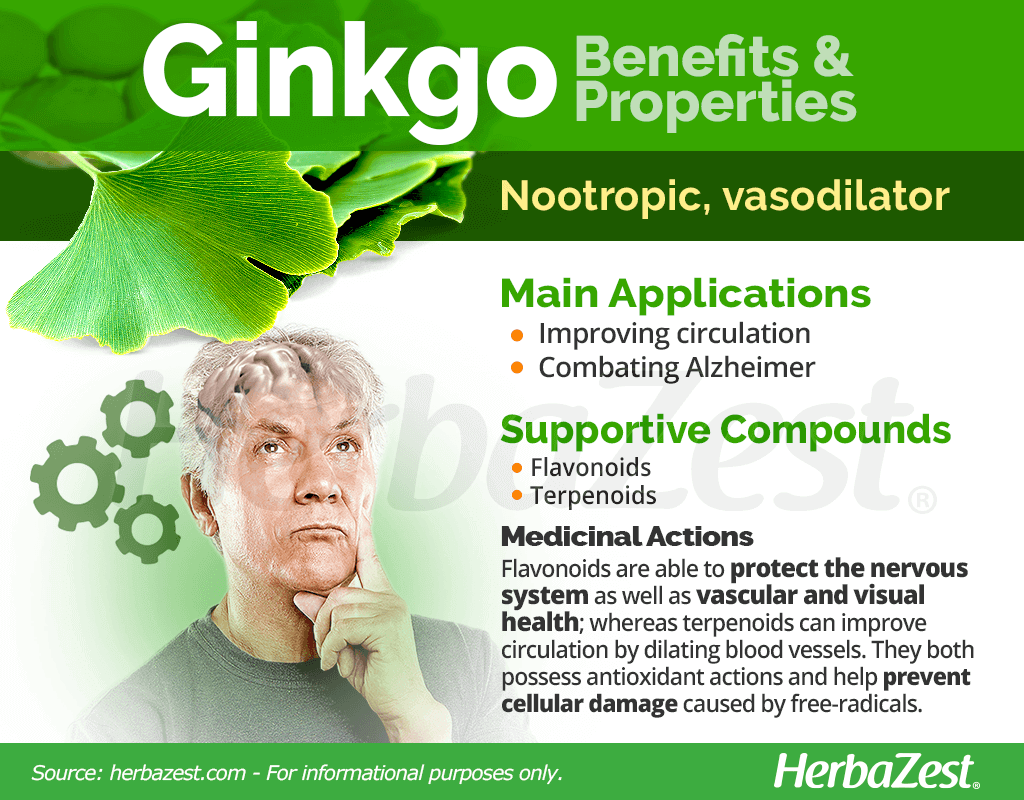
How to Consume Ginkgo
Ginkgo is not one of the most popular medicinal herbs, but its potential is acknowledged by herbalists. As such, it is available to buy in the form of various health supplements. Although it is possible to consume the fresh, raw ginkgo leaves, they are not generally easy to find.
In China, ginkgo nuts are revered and often appear in recipes for special occasion,s such as weddings and the Chinese New Year.
Natural Forms
Infusion. The leaves of ginkgo, fresh or dried, can be stepped in hot water for few minutes to obtain an infusion that offers all the medicinal properties of this herb.
Powder. Ginkgo powder is made from dried and ground leaves. It should be consumed with water, juice or milk. It is important to take the recommended doses to achieve the desired benefits without side effects.
Herbal Remedies & Supplements
Tincture. This preparation can be purchased or prepared at home, macerating the ginkgo leaves in neutral alcohol. Tincture is one of the preferred ways of consuming ginkgo, since it has a long shelf-life and is diluted in water before drinking.
Ointment. This can be suitable for stimulating blood flow for those who have poor circulation. It can treat areas affected by pins and needles as well as improve circulation in legs in those who suffer from Peripheral Artery Disease (PAD).
Capsules. These are perhaps the most popular form of ginkgo supplements, because they are a fast method of ingestion and come in standardized doses.

Growing
Ginkgo is a popular plant among gardeners due to its ability to tolerate a wide variety of soils and climate conditions as well as its disease-resistant nature, and its tolerance to air pollution and urban environments.
The tree is slow growing, adapted to many ecological conditions and shows numerous adaptation in developmental patterns. A general understanding of its favored conditions is helpful when endeavoring to cultivate this plant.
Growing Guidelines
Ginkgo prefers deep, moist, sandy soil and requires full sun. In subtropical climates or in soils over wet or dry, the plant does not grow very well.
It is somewhat sensitive to frost, but can tolerate temperatures as low as 5°F (-15°C).
The ginkgo tree grows best in USDA zones 4 – 9, in well-drained soil, with a pH of 5 – 5.5.
In order to guarantee an optimal growth, adequate space should be allocated, as the ginkgo tree can spread up to 26 feet (8 m).
Regular irrigation and minimal application of fertilizer is advised
- Life cycle Perennial
- Harvested parts Leaves, Fruit
- Light requirements Full sun
- Soil Loamy sand, Well-drained
- Soil pH 5.1 – 5.5 (Strongly acidic)
- Growing habitat Everywhere except tundra
- USDA Plant Hardiness Zones 4a, 4b, 5a, 5b, 6a, 6b, 7a, 7b, 8a, 8b
Additional Information
Plant Biology
Carbon dating has revealed that Ginkgo biloba fossils date as far back as 270 million years ago, making ginkgo the oldest tree species still in existence.
Ginkgo averages 66 - 115 feet (20 - 35 m) in height and can spread up to 26 feet (8 m). The leaves are green to yellow and are spread like a fan. After 20 to 35 years of growth, female trees will develop fruits - or seeds - which are yellow, fleshy, and spherical, resembling plums; when these fall and decay, they exude a strong, rancid smell.
A ginkgo tree can live for thousands of years, the oldest recorded being 3500 years old.
Classification
The ginkgo tree (Ginkgo biloba) has a unique botanical background. It belongs to the family known as Ginkgoaceae, and it is the only remaining species within its family and genus.
Varieties and Subspecies of Ginkgo
11 species of ginkgo have been recorded in fossil history, although they are no longer in existence. These former versions of the plant were natively distributed throughout the world, though the fossil record indicates that they disappeared in North America roughly seven million years ago and later in Europe 2.5 million years ago. A combination of adaptive assets has allowed the sole surviving species to flourish.
Historical Information
Ginkgo has a long history in China and appears in religious and medical texts. Confucius (551 - 479 BC) was said to have taught while sitting beneath a ginkgo tree, and Taoist philosopher Zhang Daoling is believed to have planted the tree on Mount Qingcheng circa 143 AD. This tree is still in existence and remains an important shrine to the “Heavenly Teacher”.
Ginkgo trees did not appear in Europe until 1727, when Dutch traders brought it back from Japan. They were spread across the continent, and in 1754, they were planted in England's Kew Gardens where they still stand today.
Economic Data
Harvesting ginkgo seeds, for both culinary and pharmaceutical purposes, forms an industry that provides the sole means of livelihood in China for thousands of families, who are in charge of about 90% of the plant's global production. Approximately $65 million USD was generated from exports in the country in 2011 alone. It was estimated, however, that commercial cultivation of the product was highest in France and Germany in the same year.
Popular Beliefs
As the tree ages, stalactites can develop on the trunk, which many people believe resemble the appearance of breasts. In Sendai, Japan, there is a ginkgo tree which is said to stand upon the grave of a wet nurse who was employed by an emperor. It is believed that she pledged to Buddha that she would provide milk to all babies who could not receive any from their mothers. This myth has led to many woman visiting the site to pray that they can nurse their children.
Other Uses
Gardening. Throughout the world, ginkgo is widely cultivated as an ornamental plant. It is also a frequent choice in city planning for adding green to urban areas across the globe.
Carpentry. The wood of the ginkgo tree is often favored for making furniture due to its strength, good color, and the fact that it polishes well.
Ginkgo is an interesting and unique species, which offers in the foreseeable future, which will likely reveal further medicinal properties and, consequently, more conditions that the plant could potentially treat.
- Other uses Furniture/carpentry
Sources
- European Journal of Neurology, Ginkgo biloba and donepezil: a comparison in the treatment of Alzheimer's dementia in a randomized placebo-controlled double-blind study, 2006
- Kew Royal Botanical Gardens, Ginkgo biloba
- National Center for Complementary and Integrative Health, Ginkgo
- MedlinePlus Herbs and Supplements, Ginkgo
- University of Maryland Medical Center, Ginkgo biloba
- Royal Horticultural Society, Ginkgo biloba
Footnotes:
- The Lancet Neurology. (2012). Long-term use of standardised ginkgo biloba extract for the prevention of Alzheimer's disease (GuidAge): a randomised placebo-controlled trial. Retrieved January 24, 2023, from: https://www.sciencedirect.com/science/article/abs/pii/S1474442212702065
- The Scientific World Journal. (2022). Evaluation of Antioxidant Activities and Tyrosinase Inhibitory Effects of Ginkgo biloba Tea Extract. Retrieved January 24, 2023, from: https://www.ncbi.nlm.nih.gov/pmc/articles/PMC8942678/
- American Journal of Hypertension. (2010). Effect of ginkgo biloba on blood pressure and incidence of hypertension in elderly men and women. Retrieved January 24, 2023, from: https://www.ncbi.nlm.nih.gov/pmc/articles/PMC2989407/
- Carbohydrate polymers. (2022). Hair-growth promoting effect and anti-inflammatory mechanism of Ginkgo biloba polysaccharides. Retrieved January 24, 2023, from: https://pubmed.ncbi.nlm.nih.gov/34973721/
